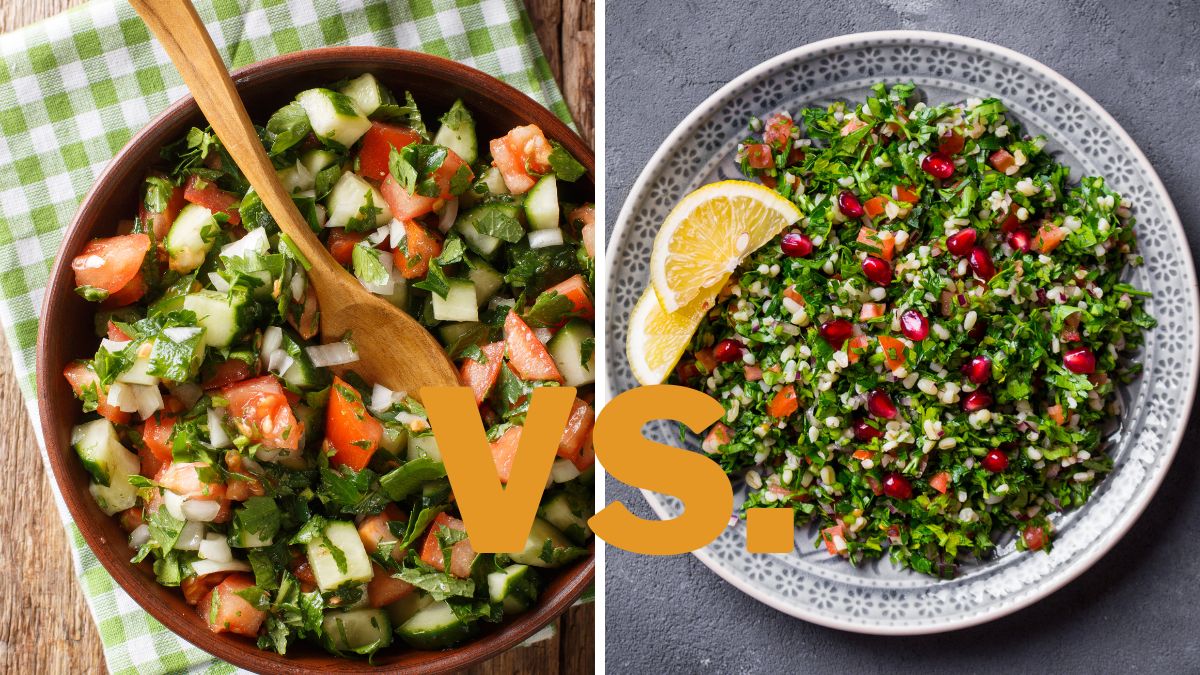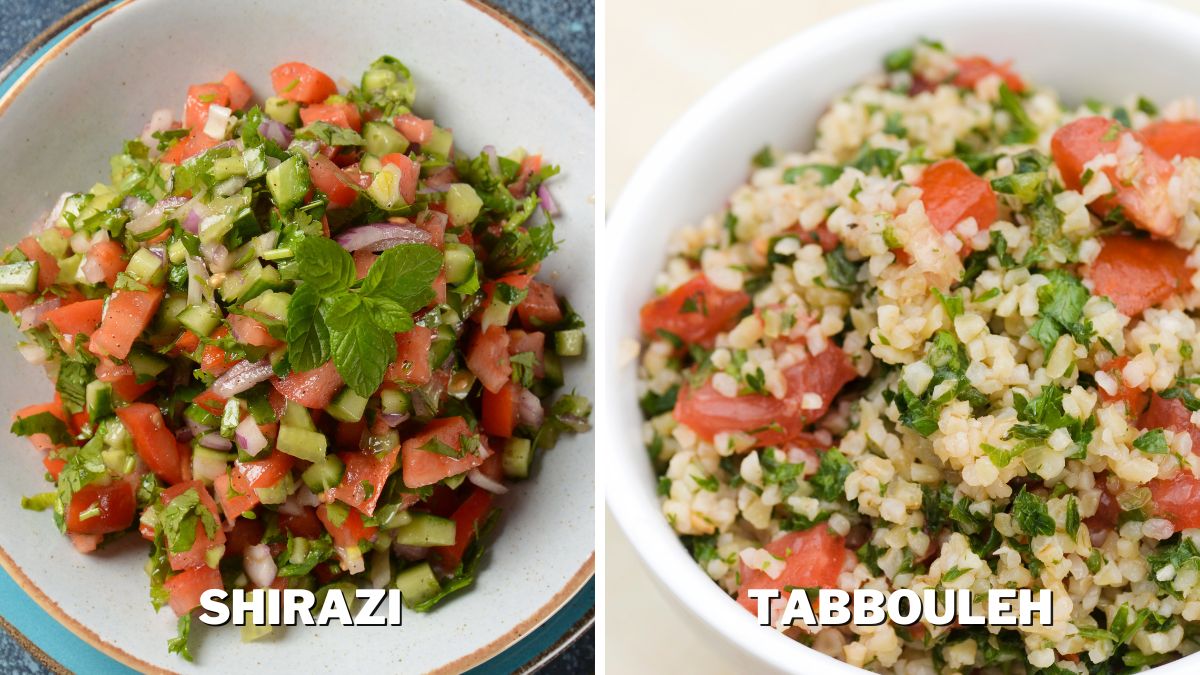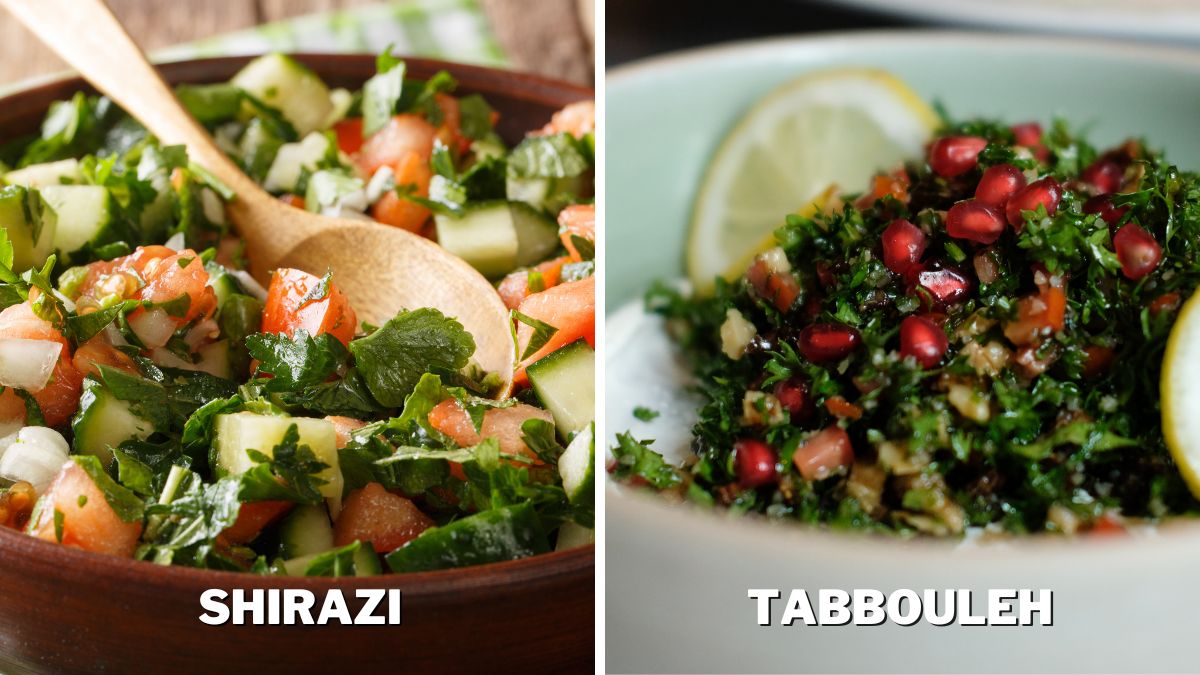Shirazi vs. Tabbouleh: Differences Between Two Middle Eastern Salads

As a food enthusiast, I love exploring different cuisines and their signature dishes. Persian cuisine is definitely close to the top of my list, with its vibrant flavors, fresh ingredients, and beneficial recipes. Two salads frequently used in Persian meals are Shirazi salad and Tabbouleh. While both are delicious, I can’t help but compare them.
Shirazi salad originates from Shiraz, Iran, while Tabbouleh comes from Lebanon. Shirazi reflects the hotter Iranian climate by using cooling cucumbers and tomatoes. Tabbouleh incorporates typical Lebanese ingredients like bulgur wheat, Middle Eastern herbs, and spices.
I’ve set out to uncover the key differences between these two popular Persian salads. From ingredients to origin and taste, there are some distinctions worth noting. For all of you salad enthusiasts, join me as I dive into the battle of Persian salads: Shirazi salad vs. Tabbouleh.
The Origins of Shirazi Salad and Tabbouleh
The origins of Shirazi salad and Tabbouleh are quite different. Made of cucumbers, tomatoes, onions, and a light lime juice dressing, Shirazi salad hails from the city of Shiraz in southern Iran.
Tabbouleh, on the other hand, comes from Lebanon. While Shirazi salad is all about vegetables, Tabbouleh focuses on parsley and includes bulgur wheat, mint, olive oil, and lemon juice. Lots and lots of chopped parsley.
If you’re not a big fan of parsley, Tabbouleh might not be for you. The bulgur wheat gives Tabbouleh a heartier, grainy texture compared to the crisp freshness of Shirazi salad.
Key Ingredient Differences Between Shirazi Salad and Tabbouleh

Shirazi salad primarily consists of tomatoes, cucumbers, onions, and a simple lime juice dressing. The ingredients are all chopped up and marinated in lime juice, which gives it a bright, acidic kick. I often toss in some olive oil, mint, and chili peppers for extra flavor.
Conversely, Tabbouleh is mostly parsley, mint, bulgur wheat, tomatoes, and lemon juice. The herbs are finely chopped and mixed with the bulgur wheat and vegetables. Parsley makes up the bulk of the salad, along with tomatoes, mint, onion, olive oil, and lemon juice. The wheat adds an earthy, nutty flavor and chewy texture.
- Shirazi salad focuses on fresh veggies, while Tabbouleh has a grain base
- Shirazi salad uses lime juice, and Tabbouleh uses lemon juice
- Mint is prominent in Tabbouleh but not used in Shirazi salad.
How the Taste Profiles Differ Between These Persian Salads
While both of these salads feature fresh ingredients and a tangy taste, their profiles differ quite.
Because Shirazi salad features more acidic ingredients, it has a tangier, zestier flavor. The lime juice gives it a punch of citrus that lingers on your palate. The cucumbers add a cooling quality.
Tabbouleh tastes lighter and more verdant with the blend of fresh chopped parsley, mint, and lemon juice. While still bright, it’s more mellow than the tart Shirazi salad. The bulgur wheat provides an earthy, nutty flavor.
In the end, while both salads are delicious and refreshing, Shirazi salad and Tabbouleh each have a distinct set of ingredients and tastes that make them unique. I say, why choose when you can enjoy them both?
Which Is More Popular: Shirazi Salad or Tabbouleh?

Both salads are popular throughout the Middle East, but Shirazi salad remains most closely associated with Persian cuisine.
Tabbouleh is made primarily from freshly chopped parsley, mint, tomatoes, and cucumbers — all ingredients with a high water content that gives it a light, refreshing quality. Shirazi salad also uses cucumbers and tomatoes but has a heavier base of onions and usually uses dried lime juice for tartiness rather than fresh lemon juice. The fresher ingredients in Tabbouleh make it perfect for hot summer days.
Both salads are nutritious, but Tabbouleh has a nutritional edge thanks to all the fresh parsley, which is loaded with vitamins K, C, and A. Parsley also acts as a natural breath freshener, giving Tabbouleh another point in its favor. [1]
Middle Eastern salads have gained global popularity, and Tabbouleh seems to have captured the public’s attention more than Shirazi salad. Tabbouleh has become popular in Western cuisine and can be found in most grocery stores, while Shirazi salad remains more obscure outside of Iran. This wider recognition and availability also contributes to Tabbouleh’s popularity, at least in my view.
Which one do you think is more popular? Let me know what you think in the comments below!
